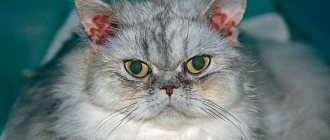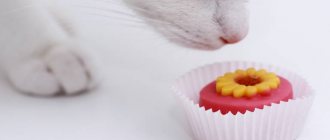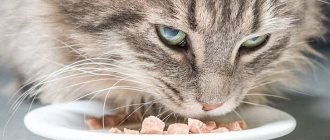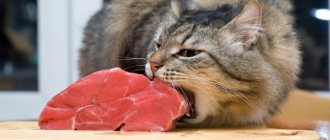Ice cream is so delicious on a summer day, but will it harm our furry pet? Can a cat eat some ice cream?
One of the most harmful foods for cats is sweets. Especially chocolate ones.
Does your cat like to eat ice cream?
The heat is at its peak and people are cooling off as best they can. However, ice cream is a treat that we enjoy all year round, not just in the summer. Our pets love to stick their noses into everything we eat. What about ice cream? Can we offer this type of cooling to a cat? Can I give my cat some ice cream?
Should it be given to kittens and adult cats?
Veterinarians and cat breeders believe that giving ice cream to pets is extremely undesirable.
But a lot still depends on the portion. If it’s a teaspoon of milky delicacy and not every day, but once every 1-2 months, then nothing bad will happen. If you abuse sweet dessert and give it in large quantities, the consequences can be sad.
The fact is that cats do not have taste buds that recognize sugar. Therefore, for the most part, they do not need it. The exception is animals weakened after a serious illness (at the recovery stage). If you give ice cream regularly, there may be problems with the kidneys, liver or other organs.
Note! If the product is natural (without milk substitute), then it is safer for your pet than if it contains artificial additives, preservatives, dyes, etc. Chocolate ice cream is especially dangerous for cats, but this will be discussed below.
Cream
Whole milk ice cream is considered less dangerous for cats, unlike other types of sweet treats. Therefore, it is still possible to give it in small quantities (1 teaspoon or dessert spoon, and no more than 1-2 times a month).
But, if the package says that it contains milk fat substitutes, it is better not to risk it and choose something else as a cool treat, for example, chilled milk.
Chocolate
Chocolate ice cream is the most dangerous type of food for cats. The fact is that it contains theobromine (a purine alkaloid found in cocoa beans and ground powder), which can cause intoxication (poisoning) in the animal’s body.
The consequences in this case can be very different - from diarrhea and digestive disorders to heart rhythm disturbances, increased anxiety, aggression and fear.
Accumulating in large quantities in the body (if chocolate ice cream is given frequently), theobromine can lead to serious changes in the pet’s health.
Fruit ice and others
Giving cats fruit ice and other types of ice cream with dyes, flavors and flavor enhancers (for example, banana, strawberry, etc.) is extremely undesirable, because they contain pure “chemistry”. Adverse reactions may include vomiting, diarrhea and refusal to eat.
Need for sugar
Many cat owners note that their pets gobble up chocolate, condensed milk or cake with great pleasure. Animals are often treated to candy from the owner’s table, in the belief that they simply adore confectionery.
In fact, cats do not feel the taste of sweets at all, since they do not have receptors on the tongue, and on a physical level they cannot like desserts. Moreover, animals do not have certain enzymes that are responsible for digesting sugars. As a result, any sweetness will only harm the cat. Therefore, every owner must understand that under no circumstances should you feed your pet sweet foods: give the cat ice cream, cakes, chocolates.
Why not?
Ice cream should not be given to cats for a number of reasons:
- The product contains a large amount of carbohydrates and sugar, which are quickly transformed into internal and subcutaneous fat covering the liver, kidneys, heart, and the walls of blood vessels. This is especially true for those owners who abuse the dosage and too often pamper their pet with a cool dessert.
- Theobromine in chocolate ice cream can cause increased blood pressure, poisoning with diarrhea/vomiting, and increased heart rate. In rare cases, the case ends in death.
- If you give ice cream too often and in large quantities (even natural and creamy), this can lead to a weakening of the animal’s immunity and its complete dysfunction. Allergic reactions are also possible. Especially if the product is based on chemical dyes and flavor enhancers. And skin diseases, including lichen and baldness.
- Another danger is urolithiasis. When a cat's digestive system is forced to process sugar and other harmful components, in an attempt to cleanse itself, all body systems begin to work literally to wear out. Therefore, urolithiasis or kidney failure may develop as long-term consequences.
Also, when overusing dairy desserts, cats develop diabetes and vision problems, including blindness.
Important! Giving your cat ice cream occasionally and in small quantities is not as dangerous as chocolate or fruit ice cream. But veterinarians still do not advise doing this. After all, the owner acts at his own peril and risk. Kittens and old/frail animals are especially at risk.
What kind of ice cream can you give your pet?
How to refuse a cat who pityingly looks into your eyes or menacingly demands his portion of ice cream? Each cunning cat has his own ways of influencing the owner. It turns out that despite all the harmfulness of this product for a cat’s body, you can treat a cat with a small portion of ice cream. But it should be a really small portion, no more than two teaspoons. You can allow such a treat occasionally, but under no circumstances should you feed your animal ice cream on a regular basis.
Try making healthy ice cream for your pet - freeze natural yogurt, cream or goat's milk without added sugar and treat your pet in the hot weather. If your cat still prefers industrial ice cream, do not give him a chocolate treat. Chocolate is dangerous for cats.
If your cat loves ice cream, you can treat her with a small piece occasionally as an exception. But it is still preferable to choose real cat treats for her, which are sold in any pet store. This is how you will keep your cat healthy for many years.
What to do if you eat it?
If a cat has eaten a small amount of ice cream (for example, cream) nothing bad will happen. In most cases, pets do not have any reaction at all.
But it all depends on the animal’s body: in case of allergies or intolerance to components, signs of intoxication may occur (vomiting, diarrhea, weakness, etc.). Or behavioral disorders (fear, panic, anxiety, aggression). The latter is relevant when eating chocolate or fruit ice cream.
The only thing that can be done in this case is to give the pet an enterosorbent (dissolve 1-2 tablets of activated carbon or Enterosgel in water). The medicine should be poured from a syringe without a needle into the corner of the animal’s mouth. If necessary, it is recommended to repeat the procedure, but not less than after 1.5-2 hours.
And in order for harmful components to be eliminated from the fluffy’s body faster, you need to give as much clean water as possible. If your pet refuses to drink, you will have to force the liquid in through a syringe. But you need to act carefully and affectionately, without causing severe anxiety to the animal.
There is only one way to prevent intoxication - do not give ice cream to your cat. Especially if negative reactions have already been observed. Therefore, the product should not lie openly on a table or any other place where the pet has access.
Why does a cat show interest in sweets?
Animals do not have consciousness, they do not reason, but act based on instincts. And despite the fact that our pets live in warmth and abundance, they do not have to hunt all night in search of food, they cannot be changed. Instinct says exactly one thing. If food is quickly digested and provides a lot of energy, this is exactly what you need. Of course, sugar in this regard is just an ideal food.
That's not all. Many sweets contain proteins and carbohydrates, vegetable and dairy fats and other elements that are certainly beneficial for the cat’s body. Based on this, most owners are ready to make a sudden conclusion that desserts will only benefit their pet. But you need to ask your veterinarian whether cats can have sweets, and only after that include a new product in your pet’s diet. Today we rely on the opinion of practicing veterinarians.
Why do they freeze after trying?
On the Internet (including YouTube) you can find videos in which cats behave strangely after eating ice cream - throwing their heads back, suddenly freezing in one place, or showing signs of anxiety.
And there is a completely reasonable explanation for this: a cold product affects the language receptors and nervous system of the animal, hence such reactions.
In addition, if the composition contains theobromine (chocolate ice cream) or chemical components (dyes, flavors, etc.), this may have a negative effect on the digestive system or cause allergic reactions.
Excess energy and home lifestyle
Why do we limit the amount of sweets ourselves? Because we know about the high carbohydrate content in desserts. When consuming them, you need to maintain the most active and energetic lifestyle possible. Most of us cannot boast of such a thing. We have just enough activity to go to the store after work. But our pets today do not have the opportunity to realize their full potential. This is especially true for cats that live in small apartments. And again ask yourself the question: “Can cats be given sweets?” Of course not.
These treats will lead to the accumulation of fatty deposits. This is a very dangerous condition for furry pets. It impairs the functioning of internal organs and other important systems. That is, if you give a cat sweets, you provoke his early death.
How to replace a sweet treat?
Ice cream for cats has not yet been invented. But if you wish, you can always find a worthy replacement. Here is one of the delicious and healthy recipes:
- Take natural yogurt in the required proportions, for example 100 ml (preferably homemade, without sugar and dyes).
- Add a couple of teaspoons of kefir and cottage cheese to it.
- Mix the ingredients thoroughly and place in the freezer for 30 minutes.
Cool treat for cats is ready!
Chilled milk or kefir will also come in handy in the summer heat. The pet will definitely like it and will not cause negative reactions from the body.
So can cats eat ice cream?
We say no! This sweet food is meant for people after all. Especially chocolate!
- Treating your cat to sweets can cause serious complications.
- It can also contribute to the formation of tooth decay and serious periodontal disease, as well as obesity - a disease of the 21st century not only in humans.
However, when it comes to ice cream for cats and products that are safe for cats and the ones they like - you can do it, but it's worth remembering that there are other, less risky ways to cool your pet in the summer.
What happens in the body?
You need to understand well how the cat’s gastrointestinal tract and other organs react to the intake of large amounts of sugar, fat, thickeners and preservatives, which we call desserts. Cats need protein and a minimum amount of carbohydrates. That is, the required element is replaced with a surrogate. Sugar is not only useless for them, but also harmful.
If we talk about chocolate, it is completely poisonous. A tiny portion leads to a surge in blood pressure and increased heart rate. In large quantities it causes intoxication and death. Sweets are especially dangerous for aging and pregnant animals. In an elderly cat, even one piece of candy can cause itching, drooling, and a sharp decrease in vision. That is, the matter is not at all limited to banal allergies.
Continuing to talk about whether cats can eat sweets, veterinarians note that regular consumption of desserts leads to impaired kidney function and urolithiasis. Don't forget that cats are prone to diabetes. And excess sugar creates an increased load on the thyroid gland, which contributes to excess insulin synthesis.
When does a cat need sugar?
In rare cases, a cat needs sugar as medicine. This phenomenon occurs during the recovery period of an animal after a serious illness, when it is exhausted and there is a reduced level of sugar in its blood compared to what it should be normally. However, sweet medicine can only be used as prescribed by a veterinarian. The cat owner himself should not prescribe such therapy.
In this situation, the cat is given a glucose solution or regular sweetened water. During such treatment, strict monitoring of the animal’s condition is required in order to promptly stop the supply of sweets. Even during treatment, the following sweets are prohibited for the animal :
- confectionery;
- sweet dairy products;
- chocolate;
- sweet carbonated drinks (some cats readily drink them).
In order not to harm your pet, you must strictly follow all the veterinarian’s recommendations. If the cat is not ready to drink sweetened water, it may be forced to drink it. It is also not uncommon to resort to the simplest method and give the pet IVs with glucose, which can be not only intravenous, but also subcutaneous.
You cannot uncontrollably use sweet therapy for a cat, even when she is old and she always gets better after it. A loving owner should know how to properly support an animal, and therefore older cats need to be managed by a veterinarian.
What's the best way to give?
It is not advisable to treat your pet to boiled parts of a bird's skeleton. If, nevertheless, the owner prefers to feed the cat chicken breast or other bones, then it is worth knowing how to feed the animal with them correctly in order to reduce the risks of deviations and negative consequences. When feeding such products, adhere to the following recommendations:
- Completely exclude tubular bones from the cat’s diet, which, when the pet eats, break into sharp fragments that injure the mucous membranes.
- It is forbidden to feed boiled chicken, which becomes even harder. Due to heat treatment, bones are less digestible.
- Chicken skin, bone structures, legs and necks should be hammered or processed into minced meat before serving. In this case, it is necessary to remove hard parts such as beaks and others.
- For adult felines, it is necessary to feed no more than 5-10% of bones from the total diet. If there is a lot of such food, then there is a high probability of constipation or intestinal obstruction.
- Kittens and older animals should not consume such products, since their jaws are weaker and cannot always bite through hard pieces.
Accessories, tools and methods
If the above methods do not help protect your cat from the heat, you may want to try additional methods. The cat will feel better if its physical activity is reduced as much as possible, so bowls, a tray and a bed should be placed in the same room.
Advice: if the cat refuses to eat in the heat, do not insist; if the pet refuses to drink water, consult a doctor immediately.
homemade ice cream as an extreme coolant . Naturally, the product is contraindicated for cats with lactose intolerance and should not contain sugar. Ice cream is fed to the cat from a teaspoon in a slightly melted state.
Many owners decide to cut their cat's hair to ease its suffering. Grooming as a method is not prohibited, but as mentioned above, a pet cannot be cut to zero. The more important point is combing. By summer, the cat's undercoat (if any) is completely shed and must be thoroughly combed out . The higher the air temperature becomes, the coarser the pet's fur will become and this is normal. In the process of increasing the stiffness of the guard hair, the cat may lose a small part of the old hair, this is also normal.
Important! Hairless cats that like to lie in the sun should be dressed in white, cotton or linen clothing in hot weather. The white color reflects ultraviolet rays, which will protect your pet's skin from heat and burns.
Even if your pet doesn't like water, place a small bathtub freely accessible. Cats are not afraid of water, but they do not get into it unless necessary. Increased air temperature is the most natural need to wet the wool known in nature.
This is interesting: How much should a cat eat per day?
How to help a cat during a heat wave
Adult cats and kittens can tolerate heat without any problems if the room humidity is normal and the temperature does not rise above 25°. Naturally, without air conditioning, such conditions cannot be maintained all summer (if your climate has hot summers). Even at 25°C, the room needs to be regularly ventilated, or better yet, leave the windows in the apartment open all day. However, here it is worth considering one more danger - the cat may fall out of the window, and windows in ventilation mode can become a death trap for the pet.
A healthy cat exposed to heat will try to exercise less and sleep more . This simple method allows you to reduce the intensity of work of all organs, and with it the body temperature. Even in extreme heat, a cat can sleep alternately in the sun and in the shade; there is nothing strange in this, since this is how the cat maintains a comfortable body temperature, practically without expending energy. By the way, in the heat, a cat’s appetite deteriorates greatly , so saving energy becomes a very pressing issue.
Important! A cat can fall asleep in direct sunlight and this is really dangerous. Draw the curtains or wake your pet if he seems hot. A cat without fur that falls asleep in direct sunlight can get burned.
Many cats learn over time that water helps them cool quickly . If your pet is good with water, he should be offered to cool off under a thin stream of water. The key word here is to suggest that you should not forcefully wet the crumbs. Even if your pet doesn't like water, leave the bathroom door open when leaving for work. Traditionally, the bathroom is the coolest room in the house, and if the floor is ceramic tiles, the cat can cool down by lying on it.
Important! Elderly animals and cats suffering from chronic inflammation of the joints are strictly not recommended to lie on a cold floor (tile) even in hot weather.
When it comes to cooling, you also need to know when to stop. Your cat should not sleep in a draft or under air flow from an air conditioner. You should not give your pet cold or frozen food; this approach is powerless in the fight against heat, but your cat can easily catch a cold. At high air temperatures and low humidity, the animal’s condition can be alleviated by hanging wet cloths (towels, sheets, bedspreads) on windows and vents.
Important! Make sure your cat has fresh water in hot weather. It is necessary not only to change the water 1-3 times a day, but also to wash the bowl from plaque.
Milk is often the main ingredient in ice cream
To make matters worse, it is not cat milk, but milk from a female of another species. What does it mean? Kittens, like all mammals, eat food produced by their mother early in their lives. Cow's milk is not suitable for them - it is fattier and contains more calories for the same volume. More importantly, once solids are started (which occurs around 4-8 weeks of age), the body gradually stops producing the enzyme responsible for digesting lactose. For this reason, giving milk or dairy products (such as ice cream) to an animal can lead to unwanted gastrointestinal reactions. This, in turn, manifests itself in unpleasant ailments such as abdominal pain or diarrhea.
At-risk groups
Just like people, there are risk groups among cats. Overheating threatens every cat without exception, the only question is the critical temperature . It is worth considering that animals individually tolerate air humidity in hot weather; some cats do better in dry air, while others do better in humid air. Animals at risk for heatstroke include those suffering from:
- Chronic diseases of the heart, vascular system, respiratory tract, hormonal system.
- Obesity, which is considered not a disadvantage or a temporary problem, but a disease.
- Natural degenerative changes (elderly animals over 7–8 years old).
A special risk group includes cats with shortened and depressed faces. Such breeds have breathing problems, and in the heat, only steamy air circulation through the respiratory tract saves the cat from overheating. Hairless cats (Sphynxes, Levkoi) are also prone to overheating, since fur not only warms or decorates, but also performs the function of thermoregulation.
Some cats have an undercoat, but regardless of its presence, there is a so-called air chamber under the cat's fur. The air in this chamber maintains a constant temperature of 38–39° , which helps the cat warm up in the cold and maintain normal body temperature in the heat. Many owners cut their cats' hair to help them cope with the heat, but in fact, short haircuts cause even more problems . A long-haired cat can be trimmed with scissors, but cutting off the fur completely is not recommended.
Note! The only case in which a clipper haircut is relevant is when there are a large number of tangles.
Owners of pets at risk need to prepare for the heat responsibly. Visit your veterinarian for advice on the best treatment options. Animals suffering from heart failure are prescribed maintenance therapy during the summer. Ask your doctor what medications you need to have on hand if your pet becomes ill and how to provide the most competent first aid.
This is interesting: How much food to give a cat
Symptoms of chocolate toxicity
There are many symptoms of chocolate poisoning in cats, and they vary from cat to cat and on how much chocolate has been ingested. Mild symptoms include:
- Vomit. Gross for you but good for your cat as it is one of the best ways to get rid of chocolate quickly.
- Diarrhea
- Anxiety/hyperactivity
- Dehydration
- Tremor
- Convulsions
- Stiffness
- Rapid breathing
- Coma
In the most severe cases, unfortunately, too much chocolate is fatal.











